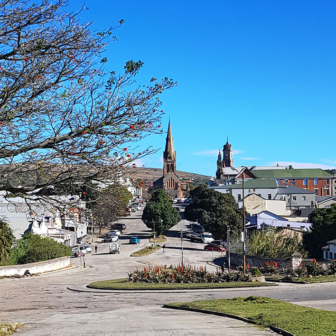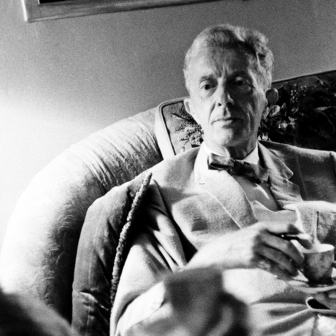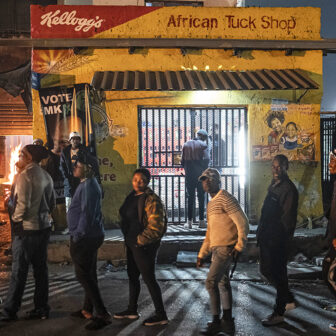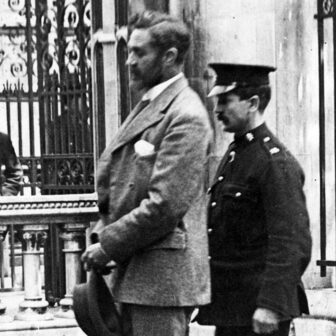A forty-two-car convoy creeps up a large hill on a small farm just outside the town of Ventersdorp, in South Africa’s North-West province. The farm once belonged to Eugène Terre’Blanche, and this troop of loyal supporters have come to visit his grave, pay their respects and ponder their future in the (not so) “new” South Africa.
Until his death, Terre’Blanche was the leader of the Afrikaner Weerstandsbeweging (Afrikaner Resistance Movement), or AWB, a radical far-right organisation of Afrikaans-speaking South Africans. It was famous for its hardline, militant opposition to change in the 1980s and early 1990s. In 2001 Terre’Blanche was jailed for attempting to kill a black security guard.
In April 2010, six years after he had been released from jail – evangelised and committed as ever to the reclamation of land and the establishment of Afrikaner self-government – Terre’Blanche was bludgeoned to death in his own bed by two of his farm servants.
His killing was a farm murder like the hundreds that provide key emotional ammunition for organisations like the AWB. But it was made all the more controversial by the discovery of fresh semen in his pants, and there were accusations that Terre’Blanche had molested his servants. Even posthumously Terre’Blanche could stir the South African headlines like few others.
It has been a year now since his death, hence the gathering at his farm in Ventersdorp. After the memorial service, one of the leading cars gets bogged on its way back down the hill. The impressive convoy comes to a grinding halt; the cars’ giant, Nazi-like AWB flags fall limp. After a while, a few of the bigger cars break away. What was once a precise and orderly movement disperses into a cluster of confusion.
And so it has been for the AWB in recent times. After Terre’Blanche died, the members became disoriented. The AWB was torn over who would be Terre’Blanche’s successor – Steyn van Ronge or André Visagie – and for a short time, there was considerable tension in the ranks. Van Ronge, producing a fax that proved Terre’Blanche had preferred him, eventually squeezed Visagie out of the race.
This was not long after a notorious incident on live TV in which Visagie, representing the AWB, lost his temper with the show’s black host, to his significant discredit and YouTube infamy. Disenchanted, and expunged from the AWB’s leadership team, Visagie broke away with a few loyal supporters and started his own group, the Geloftevolk Republikeine (Republican People of the Covenant), continuing in the militant tradition of the AWB.
Just last month, Visagie’s house was raided for guns, ammunition and explosives. He now faces serious charges in a Kimberley court for unlawful possession.
Visagie’s new Geloftevolk Republikeine is not alone. Several small, far-right, hyper-Christian Afrikaner groups have sprung up across the country in the last two decades – though it is hard to believe. Today there are about forty of them in total, at least five of which with blatantly militant designs. None is politically influential – not even remotely – but they are frightening.
One of these is Die Brandwag (the Sentinel), another organisation prominent in the North-West Province, which was represented by several camouflage-clad members at the memorial for Terre’Blanche. Further south, in the corner of the Free State province and Lesotho, Die Kommando Korps operate; members participate in target shooting competitions every second weekend, and train boys as young as thirteen years old to handle semi-automatic rifles. They consider themselves the protective force for white farmers experiencing problems with illegal Basotho border-jumpers. Over in the northern regions of the Northern Cape is perhaps the most bizarre organisation, Die Suidlanders (the South Landers). Their so-called “safe haven plan” is to establish a number of armed refugee camps for Afrikaners in the event of Nelson Mandela’s death (an incident which they believe will inspire an outbreak of civil war across the country).
A common explanation for this new kind of privatised Afrikaner militancy is that it has grown in response to former President Thabo Mbeki’s disbandment of the military commandos that had been sponsored by the South African defence force. Before they were phased out from 2000, these commandos had been around for centuries in various forms. They originated in the era of the frontier – bands of men, mostly white, who acted as laws unto themselves in regions where jurisdiction was contested and uncertain. They operated in more or less the same way in the twentieth century, though they had become almost exclusively white by then.
Nowadays, with the commandos gone, a new era of South African history has dawned – but farmers are not optimistic about it. With the South African police as stretched as they are in rural areas, farm crimes, Boers insist, are going uninvestigated and unpunished.
Despite the proliferation of hardliner organisations, the AWB (“Ahh Veer Beer” in Afrikaans) remains the best-known in South Africa. Its history and size outdo all others. Most average South Africans – or at least those older than thirty – can recall the time the AWB seized the Kempton Park World Trade Centre, or the time it disastrously intervened in Bophuthatswana, or the time Terre’Blanche fell off his horse at a rally in Pretoria.
The town of Ventersdorp has always been associated with the organisation. In the 1980s and early 1990s, the AWB ran its operations out of the town. Indeed, the town virtually belonged to the AWB and its “security” forces. The National Party could never control it – something they learned the hard way in 1991, when (white) police forces clashed with the town’s armed AWB members, resulting in the death of four people and the serious injury of dozens more.
Ventersdorp, like South Africa itself, has changed quite a bit since those days. The monument erected to memorialise the “Battle of Ventersdorp” of 1991 has been dismantled and taken to an unknown location. The AWB headquarters is now just a small building, often unmanned, behind locked gates next door to the home of Terre’Blanche’s widow, Martie. The AWB leader, van Ronge, lives not in the streets of Ventersdorp like his predecessor, but on a farm in the eastern Free State, hundreds of kilometres away.
True, there is still plenty of Afrikaner pride to be found here in Ventersdorp and in many towns across South Africa, but in the last decade a kind of political apathy has replaced what was once determined opposition.
Nationwide municipal elections are scheduled for 18 May, and local elections like these still matter quite a bit in South Africa, ever apportioned into dense little communities. Local radios and newspapers are abuzz with complaints about the persistent lack of key services, and the African National Congress looks set to lose more municipal support than it has in any other election. Helen Zille and her zealous Democratic Alliance party have undertaken a rigorous national tour in the last few months; and though the right-wing Freedom Front Plus has been less persuasive, limiting its campaign to white and mostly Afrikaans strongholds, its presence is inescapable in the national political dialogue.
Despite all of this, it remains very unlikely – frankly, impossible – that the ANC will lose its majority support in South Africa. And the Afrikaners know it. Asking around Ventersdorp, we hear with incredible consistency how democracy has brought nothing but impenetrable majority rule and higher taxes to the new South Africa.
“There are three people sitting around a table: a black man, an American, an Afrikaner,” says our Ventersdorp host, a modest and mellow man, in Afrikaans. At first we expect to hear a nasty joke of some kind, but we soon realise he’s in fact explaining why he cannot be motivated to vote.
“And there is an election coming up. Three different candidates from the same backgrounds – none of which the people at the table know. You ask the black man, ‘Who shall you vote for?’ His response will be, of course, that he is voting for the black candidate, even though he doesn’t know him! If you ask the American he will tell you, as well, that he is supporting the American candidate. It is no different for the Afrikaner in South Africa. They want to elect one of their own.”
This represents a huge discursive shift, and it’s not just limited to Ventersdorp; it’s spreading right across South Africa. Democracy has caused it.
Pride and nationalism remain, and always will remain, among the Afrikaner volk (just ask them about their history, their geskiedenis). But now these sentiments are seldom accompanied by armed rallies and hate speech – the AWB and its ilk are the exception these days. Today Afrikaner nationalism comes, for the most part, with a humble indifference, even a sense of defeatism.
Hardline groups across the country will try to mobilise the same old violent, gun-toting rhetoric made famous by the AWB in the 1980s. But those who subscribe to such notions are now a decided minority among Afrikaners – there are just a few thousand members in total, less than 1 per cent of the white Afrikaans-speaking population.
Ventersdorp is slowly and privately coming to terms with this reality. That the AWB rally following the memorial service was relocated from the Ventersdorp town park to an unspecified private location out of town, certainly suggests as much.
Election day will be a quiet affair here. •




